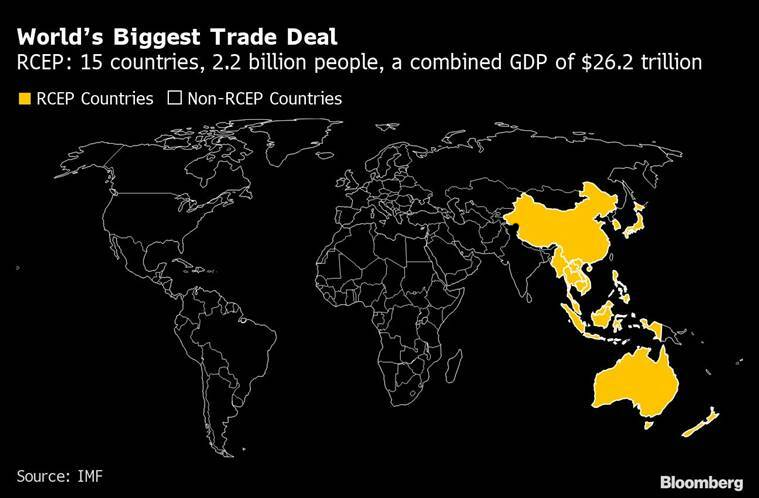RCEP Comes into Existence | 16 Nov 2020
Why in News
Recently, the Regional Comprehensive Economic Partnership (RCEP) has come into existence on the sidelines of the 37th ASEAN Summit.
- It has laid down the path for restarting discussion that had failed to admit India earlier and said “new” developments would be taken into consideration if India re-applies.
Key Points
- Regional Comprehensive Economic Partnership:
- It consists of 10 Association of Southeast Asian Nations (ASEAN) members, as well as South Korea, China, Japan, Australia and New Zealand.
- It excludes the USA, which withdrew from the Trans-Pacific Partnership (TPP) in 2017.
- Negotiations over the RCEP deal began in 2012. India was also part of the negotiations but it pulled out in 2019 over concerns that lower tariffs could hurt local producers.
- Members of the RCEP make up nearly a third of the world's population and account for 29% of global gross domestic product (GDP).
- The China-backed group will emerge as the largest free trade agreement (FTA) in the world surpassing both the US-Mexico-Canada Agreement and the European Union (EU).
- It is expected to eliminate a range of tariffs on imports within 20 years and also includes provisions on intellectual property, telecommunications, financial services, e-commerce and professional services.
- Under RCEP, parts from any member nation would be treated equally, which might give companies in RCEP countries an incentive to look within the trade region for suppliers.
- Businesses with global supply chains might face tariffs even within an FTA because their products contain components that are made elsewhere.
- The deal could increase global national income by USD 186 billion annually by 2030 and add 0.2% to the economy of its member states.
- However, some analysts think the deal is likely to benefit China, Japan and South Korea more than other member states.
- However, it could be some time before any country sees the benefits, because six Asean nations and three other nations have to ratify it before it takes effect.
- Ratification will likely be tricky in national parliaments, owing to both anti-trade and anti-China sentiments among the countries.
- It consists of 10 Association of Southeast Asian Nations (ASEAN) members, as well as South Korea, China, Japan, Australia and New Zealand.
- Significance for China:
- The beginning of RCEP is a major development that will help China and trade in the Asia-Pacific region in the post-Covid-19 scenario.
- It will give China access to Japanese and South Korean markets in a big way, as the three countries have not yet agreed on their FTA.
- While China already has a number of bilateral trade agreements, this is the first time it has signed up to a regional multilateral trade pact.
- India’s Stand:
- While addressing the ASEAN Summit, India highlighted the necessity for peace and stability in the region but maintained silence regarding RCEP as it is not very welcoming of the China-backed grouping in the light of the ongoing military tension in eastern Ladakh along the Line of Actual Control (LAC).
- In the meantime, India held Malabar Exercise with Japan and the USA for the Quadrilateral Security Dialogue (QUAD) which was interpreted as an anti-China move.
- However, these moves did not influence Japanese and Australian plans regarding RCEP.
- India ended negotiation on RCEP over terms that were perceived to be against its interests.
- One of the major concerns for India was inadequate protection against surges in imports as its industry had fears that signing RCEP would allow cheaper products from China to flood the market in India.
- The extended power to China could lead to actions and incidents eroding trust in the maritime region disrespecting the territorial integrity and sovereignty.
- For example, the ongoing tensions at LAC and Chinese activities in Pakistan-occupied Kashmir.
- RCEP on India’s Membership:
- India, as an original negotiating participant of the RCEP, has the option of joining the agreement without having to wait 18 months as stipulated for new members in the terms of the pact.
- RCEP signatory states plan to commence negotiations with India once it submits a request of its intention to join the pact "in writing", and it may participate in meetings as an observer prior to its accession.
Way Forward
- The mega trade bloc is a landmark trade initiative which is expected to boost commerce among the member-countries spread across the Asia-Pacific region.
- India needs to keep its interests on the table as the road to further expansion of its exports to RCEP member nations is very much still open, given that India already has trade and investment agreements with 12 of them.
- Utilising existing agreements better while proactively exploring new opportunities in other geographies will diversify both Indian markets as well as an export basket.
